 Oceanic Submersibles 1926-1946:
Oceanic Submersibles 1926-1946:
WW2 British Submersibles:
X1 | Odin | Parthian | Rainbow | Thames | Swordfish | Porpoise/Grampus | Shark | U class | T class | S class | U class 1940 SH | P611 class | V class (U 1941/42 LH) | X-Craft | A class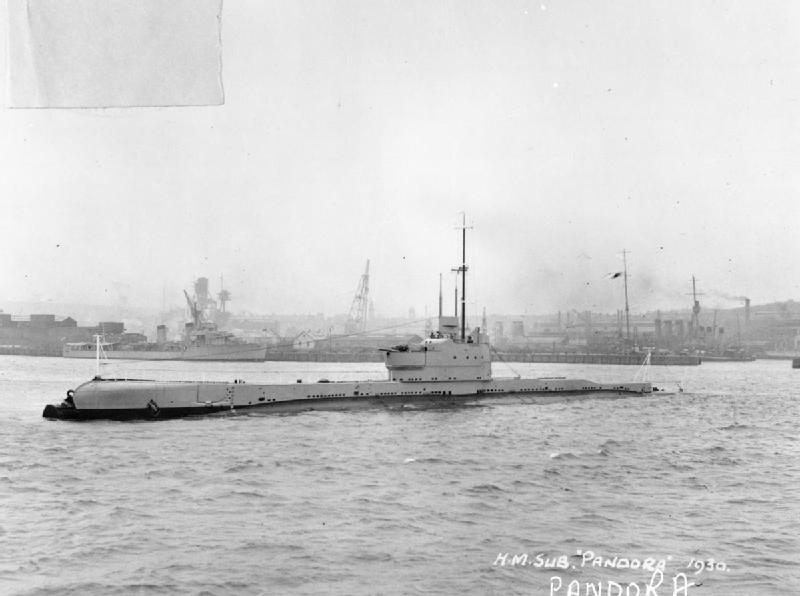
The Parthian-class submarine or P class was a class of six submarines built for the Royal Navy in the late 1920s. Also called P-class submarines, they were a group of diesel-electric submarines operated by the Royal Navy in the late 1920s and 1930s. The class consisted of six boats – HMS Pandora, Parthian (class name giver), Perseus, Phoenix, Proteus, and HMS Poseidon. The P-class submarines were also designed for fleet and coastal defense, and among the first submarines in the Royal Navy to be fitted with a fully-enclosed bridge. They paid a very heavy price to war operations, all being sunk but one. https://naval-encyclopedia.com/ww2/uk/parthian-class-submersibles.php #ww2 #royalnavy #submarine #submersible #parthianclass #pclass #pacificfleet
Design of the class
A similar class to the earlier Oberons (1927 Programme), but of a larger length, further improvements, like a raked stem and shield provided for the 4 inch gun. These were basically an incremental step, all planned to be posted on the China Station and so range and seakeeping were considerations. Like early overseas patrol subs, they followed the late 1920s ability to dive quickly (that is two feet per second), or in one minute. The range of sea-water density became a consideration from the Odin Class, including fresh water, which needed modified compensating water tanks, for a gravity of 1.00 to 1.30. Like the O and R class, ability to dive to a depth of 500 feet was not followed on the P class, which was set to 300 feet. It was believed that the capacity to dive below 500 ft would need a thicker pressure hull that would benefit also depht charge schocks underwater. But progress in this area, with larger explosive charges meant this was less of a requirement for the P class.
Hull and general design
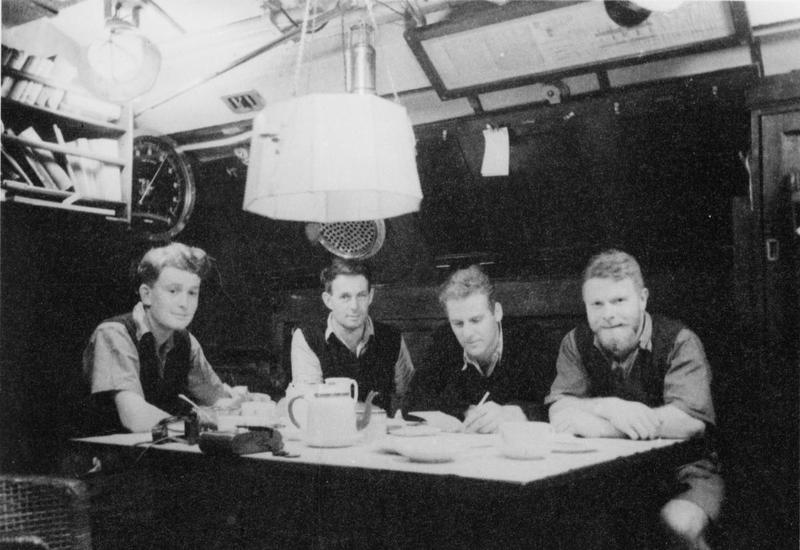
The mess of Proteus, by far the most successful of the class, sinking 14 ships. In 1944 she became a training sub in UK, the only one to survive.
The Parthian class were designed as long-range patrol submarines for the Far East. They were almost identical to the Odin class, but with a different bow shape, which was more bulbous.
These submarines had a displacement of around 1,475 tons when surfaced, 2,040 tons submerged. The hull measured 289 ft overall in lenght, 28 ft in beam, and 13ft in draught for 75ft in height, or 88.1 m in lenght oan 9.12m in beam and 4.85m in draught.
Powerplant

HMS Parthian’s machinery. likely from mag. LIFE, 1942 (pinterest)
The P class were powered by two Admiralty diesel engines for 4,600 hp in all and two 1,350 hp electric motors, for a twin screws arrangement. Top speed was 17.5 kts surfaced and 9 kts submerged, and they carried an oil Supply of 159 tons enabling a range of 8,400 nautical miles at 10 kts surfaced, or 7050 nm at 9.2 kts and 62 nm at 4 knots underwater.
They were relatively fast and maneuverable for their time, in part due to the reshaped bow, but diving time was not stellar.
Crush depth was understood below 330 ft (100 meters) as their max operational depht was referred as 312 ft (95 meters)
Armament
They were armed with eight torpedo tubes and carried up to 14 torpedoes, had a 4-inch deck gun for surface engagement, and machine guns for AA defense located aft of the conning tower. The 102mm/40 was a QF Mk IV. The machine guns were two single 12.7mm/62 (0.5 in Vickers) liquid-cooled heavy machine guns on pintle mounts either side.
Main Gun: 4-in deck gun

HMS Parthian’s CT showing her raised 4-in gun platform (pinterest)
If all the submarines in class had the same 4-in (102mm)/40 QF Mk IV installed forward of the conning tower on deck, behind a shield, HMS Perseus diverged in having the more recent QF Mk X instead. The rest was identical. This was already an old 1913 gun installed on the “Scout” light cruisers (1913), several destroyer classes and the “J”, “K”, “L”, “O” and “P” class submarines.
They fired fixes ammunitions, about 13 rounds per minute, likely HE: 47.5 lbs. (21.5 kg) rounds, with the new 5.13 lbs. (2.3 kg) SC103 or 6.0 lbs. (2.7 kg) NF059 propellant charge for 2,177 fps (664 mps) and a range of 9,600 yards (8,780 m) at 20° max elevation with their SI, 5 tons (5.1 mt) pedestal mounting. Traverse was about +120/-120 degrees.
Read more on navweaps
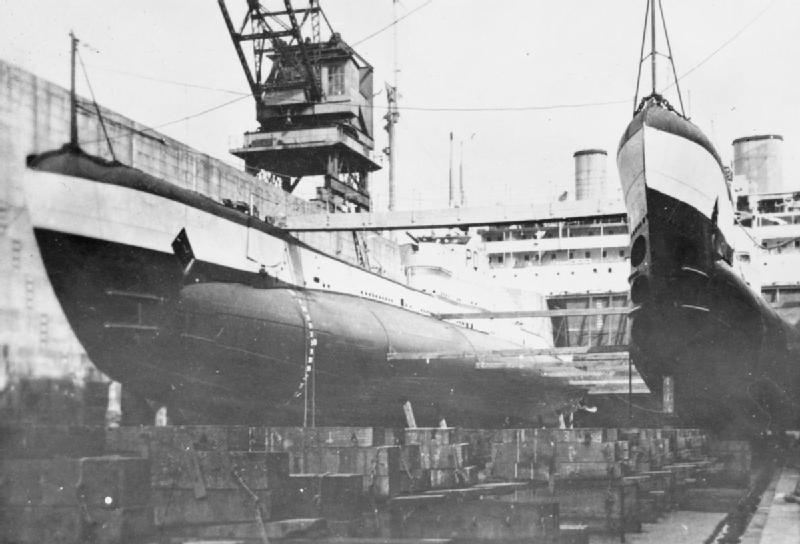
HMS Poseidon and Proteus
Torpedo Tubes
The Parthian class had eight torpedo tubes total, of 21-in or 533mm: Six at the bow, and two at the stern, for a grand total of 14 with reloads.
Torpedoes were likely the brand new (designed 1925, service 1927) 21″ (53.3 cm) Mark VIII. They were already in use with the “O” class. They weight 3,452 lbs. (1,566 kg) for 21 ft 7 in (6.579 m) in lenght, and carried a 750 lbs. (340 kg) TNT warhead at 5,000 yards (4,570 m)/40 knots, single setting. Read more on navweaps.
Sensor: Type 118 Sonar
The Type 118 Sonar was a development of the Type 116 with conical reflectors for all-round echo detection and listening, upper transducer and long rod with a lower transducer projecting from the keel, operating at 10 kHz. Its dome was made in staybrite steel. In 1929 the set was modified as the Type 118, then fitted to the second batch of O Class and Parthian Class among others.
Modernizations
At high power, their engines caused vibrations and leakage so the output was reduced by a governor, down to 4,340 hp surfaced, but still 1635 hp submerged, and top speed limited to 17 kts.
In 1930-31 Pandora, Parthian, Phoenix and Proteus had their main gun upgraded to the 4-in/40 QF Mk XII, and Perseus followed in 1933. As WW2 started, by 1941-1942 surviving HMS Pandora and Parthian were converted to cargo carriers, with spare torpedoes eliminated as part of the batteries while part of the ballast tanks were modified to hold aviation petrol.
In 1943-1944 the survivors saw a 20mm/70 Oerlikon Mk II/IV AA fitted at of the CT, and fitting to convert them as minelayers, carrying eighteen M2 mines instead of their torpedoes (same diameter). As for sensors, no change for the sonar, but a type 286W or type 291W radar was installed.
The only survivor, HMS Proteus, before decommission had hthe latest 4-in/40 S Mk I main gun, single Oerlikon AA gun Mk II S/M and her TTs intact but also the type 286W or type 291W radar.

HMS Perseus at Hong Kong, China Naval Station in the 1930s
⚙ P-class specifications |
|
| Displacement | 1,760 long tons (1,790 t) surfaced, 2,040 long tons (2,070 t) submerged |
| Dimensions | 289 x 30 x 16 ft (88 x 9.1 x 4.9 m) |
| Propulsion | 2 shafts Admiralty diesels 4,640 hp (3,460 kW), 2x EM 1,635 hp (1,219 kW) |
| Speed | 17.5 knots (20.1 mph; 32.4 km/h) surfaced, 8.6 kn (9.9 mph; 15.9 km/h) submerged |
| Armament | 8 × 21 in TTs (6 bow, 2 stern) 14 reloads, QF 4 in (102 mm) Mk V/XII, 2× 0.5 in AA |
| Crew | 53 |
The Parthian class in action
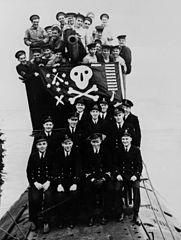 By the late 1930s, the P-class submarines were becoming obsolete, and they were gradually replaced by newer and more advanced submarines in the Royal Navy. HMS Parthian was the first to be decommissioned, in 1933, but reactivated in WW2, and the remaining were also all retired by the end of 1936 but reactivated later.
By the late 1930s, the P-class submarines were becoming obsolete, and they were gradually replaced by newer and more advanced submarines in the Royal Navy. HMS Parthian was the first to be decommissioned, in 1933, but reactivated in WW2, and the remaining were also all retired by the end of 1936 but reactivated later.
HMS Pandora (ex-Python) was built at Vickers, Barrow, launched 22 August 1929. She was sunk by Italian aircraft in harbour at Valletta, Malta, 1 April 1942; Raised but not repaired, September 1943; Hulk scrapped, 1955.
HMS Parthian was launched at Chatham Dockyard on 22 June 1929. She was lost in the Adriatic, presumed mined, 6 August – 11 August 1943
HMS Perseus was launched ay Vickers, Barrow on 22 May 1929. She was mined in the Ionian Sea between the islands of Kefallonia and Zakynthos off the west coast of Greece, 6 December 1941.
HMS Phoenix was built at Cammell Laird, launched 3 October 1929. She was also lost in WW2, presumed sunk in depth charge attack by the Italian torpedo boat Albatros off the coast of Sicily, 16 July 1940.
HMS Poseidon also was launched at Vickers, Barrow on 21 June 1929 but sank in accidental collision with a merchant steamer, 9 June 1931; Wreck alleged to have been salvaged by China during 1970s
HMS Proteus was launched at Vickers, Barrow on 23 July 1929. After an active career in WW2 she was the only suvivor of her class, being sold for scrapped in Troon, March 1946.
Read More

HMS Parthian moored alongside the Free French Surcouf. She does not seems that small when compared. She was undergoing a US refit (LIFE).
Books
Conway’s All the World’s Fighting Ships 1921-1947
Ryall, Julian (12 June 2009). Written at Weihai. “China accused of secretly salvaging sunken British submarine containing 18 lost sailors”. The Daily Telegraph. London.
Akermann, Paul (2002). Encyclopaedia of British Submarines 1901–1955 (reprint of the 1989 ed.). Penzance, Cornwall: Periscope Publishing.
Bagnasco, Erminio (1977). Submarines of World War Two. Annapolis, Maryland: Naval Institute Press.
Caruana, Joseph (2012). “Emergency Victualling of Malta During WWII”. Warship International. LXIX (4): 357–364.
Colledge, J. J.; Warlow, Ben (2006) [1969]. Ships of the Royal Navy: The Complete Record of all Fighting Ships of the Royal Navy (Rev. ed.). London: Chatham Publishing.
Chesneau, Roger, ed. (1980). Conway’s All the World’s Fighting Ships 1922–1946. Greenwich, UK: Conway Maritime Press.
McCartney, Innes (2006). British Submarines 1939–1945. New Vanguard. Vol. 129. Oxford, UK: Osprey.
Links
britsub.x10.mx parthian_class.html
rnsubs.co.uk/ parthian-class.html
battleships-cruisers.co.uk parthian.htm
uboat.net/ /3404.html
en.wikipedia.org
web.archive.org navypedia.org parthian.htm
commons.wikimedia.org parthian_class_submarine
rnsubs.co.uk/ sonar.html
rnsubs.co.uk parthian-class.html
rnsubs.co.uk/ rainbow-class.html
See a nice cutaway profile
Model Kits
Complete battle records
 HMS Pandora
HMS Pandora
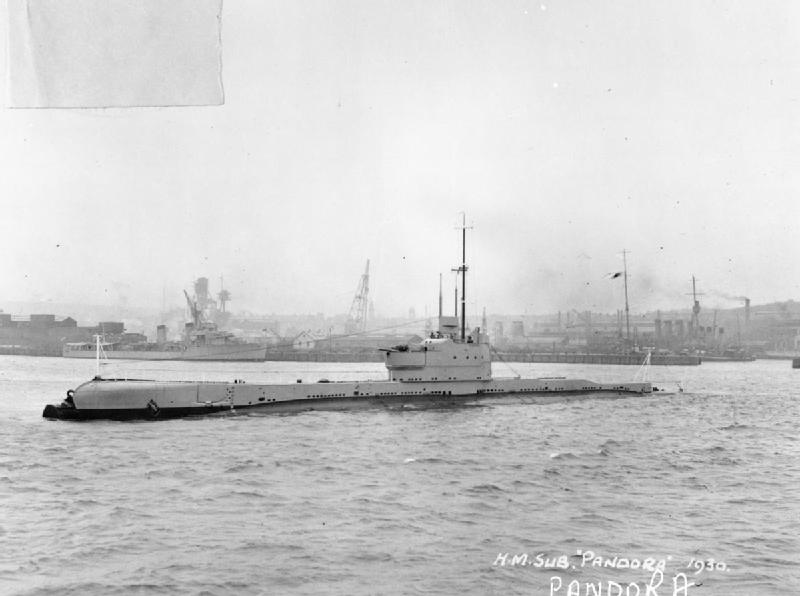
HMS Pandora was ordered as HMS Python on 7 February 1928 and laid down on 9 July 1928 at Vickers-Armstrongs (Barrow-in-Furness), launched on 22 August 1929, commissioned on 30 June 1930. By December 1930, cruised to China from Portsmouth to enter Hong Kong NS by February 1931. She served with the China Station from 1931 to 1940. That year she was part of the First Submarine Flotilla with sisters Parthian, Phoenix, Proteus but also Grampus, Rorqual, Odin, Orpheus, Olympus, Otus, Otway, Osiris, supported by the depot ship Medway.
HMS Pandora was recalled to the Mediterranean where she served from 1940 to 1942, starting with patrolling the Eastern Mediterranean by June 1940. In July she patrolled to intercept Vichy French ships off Oran. On 4 July 1940, she sank the French aviso Rigault de Genouilly off Algiers. In August she became a cargo sub for Malta.
By September she was caught by the Italian torpedo boat Enrico Cosenz, depth charged but survived. In January 1941, she sank SS Palma (south of Sardinia), SS Valdivagna and another off Cape Spartivento, Calabria. While back in Malta to be unladen on 31 March 1942 she was caught by the “blitz”, an axis raid on 1 April 1942, and she took two direct bomb hits, sinking. Fortunately her crew was not all aboard. They would later serve on HMS Olympus which sunk after hutting a naval mine (9 survivors). Her wreck was raised and stripped to be scuttled in 1950.
 HMS Parthian
HMS Parthian
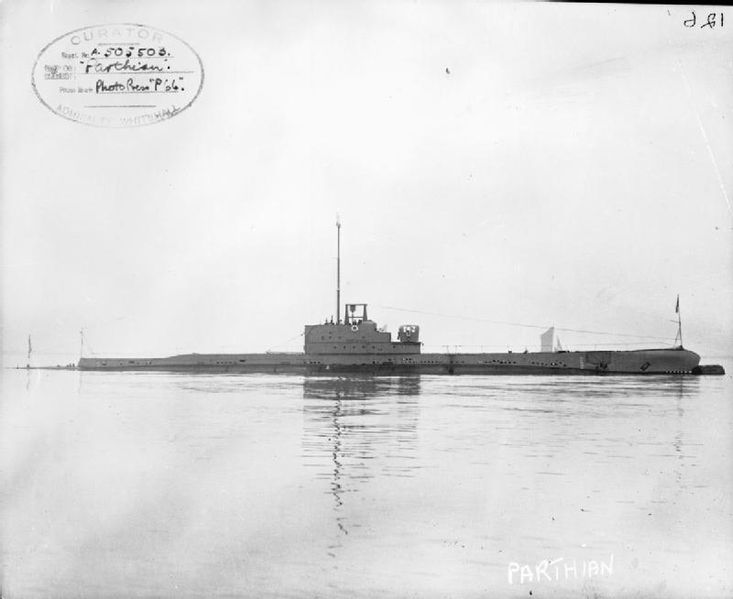
HMS Parthia was laid down on 30 June 1928 at Chatham Dockyard, launched 22 June 1929 and Commissioned on 13 January 1931. She was sent to the China Station, but in May 1940 with the new sityation in the Mediterranea, sent to Alexandria. Later on patrol, she had her first success, sinking Italian submarine Diamante off Tobruk, on 20 June. Later that year she was sent to the 8th Submarine Flotilla, based at Malta.

HSMS Parthian in Beirut, 25 Jan 1943
During another Levant patrol, she spotted and sank the Vichy French submarine Souffleur off Beirut, 25 June 1941. This wa spart of the British andFree French campaign to retake Syria-Lebanon. Later she had a refit in the US (late 1941-March 1942) as local yards were at full capacity. Back to the Mediterranean, modified as a cargo, she started supply runs in July-October to Malta, notably with precious aviation fuel and ammunition for the local air force. In May 1943 she made a tall of Italian sailing vessels in the Aegean, but her hour came on 22 July 1943. Leaving Malta to patrol southern Adriatic, then ordered off Otranto on 26 July, and back on 28 July, she was signalled on 6 August, not acknowledged and later failed enter Beirut, overdue by 11 August. The likely cause of her loss was probably a naval mine near Brindisi. Her wreck has not been discovered yet.
 HMS Perseus
HMS Perseus
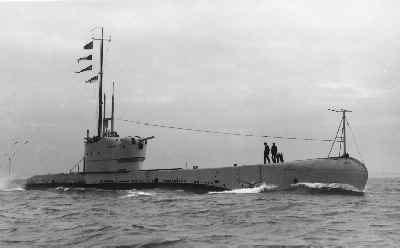
HMS Perseus was laid down on 2 July 1928 at Vickers-Armstrongs (Barrow in Furness), Launched on 22 May 1929, commissioned on 15 April 1930 and her first assignation was the China Station under Commander Peter Bartlett, 4th Submarine Flotilla, until August 1940. Redeployed to the Mediterranean she ferried supplies between Alexandria and Malta. She was refitted there from October until April 1941, escaping air raids. Next she joined the 1st Submarine Flotilla in Alexandria to patrol the Vichy-held Levant, under LtCdr. Edward Christian Frederick Nicolay. She spotted and sank the 3,867-ton Italian tanker Maya 5 off Tenedos, 5 September 1941. On 2 October she sank the 2,086-ton merchant ship Castellon, west of Benghazi, awarding him a DSO.
While sailing back from Malta to Alexandria on 26 November 1941, and instructed to patrol east of Greece she reported a ship torpedoed on 3 December, but was later lost, now assumed to be a mine on 6 December off Cephalonia, close to Zakynthos (Ionian Sea). Four managed to escape from the submarine the Twill Trunk escape hatch in the engine room. But only one, wearing the Davis Submerged Escape Apparatus survived. Her swam 8 km to Cephalonia, hidden by islanders for 18 months, then sailed to Smyrna, earning a British Empire Medal at his return.
The wreck was rediscovered in 1997 by a Greek Team and examined in detail, confirming the mine blast. There were ceremonied on 19-20 May 2000 in Cephalonia attended by surviving families of the crew.
 HMS Phoenix
HMS Phoenix
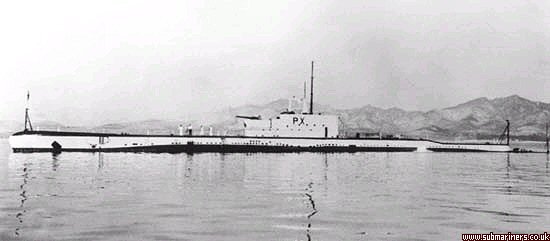
HMS Phoenix was ordered on 7 February 1928 to Cammell Laird, laid down on 23 July 1928, launched 3 October 1929, commissioned 3 February 1931. Her motto was “Resurgam” (“I will rise again”) and she joined like the others the China Station, 4th submarine flotilla. In September 1935 she was ordered back to the Mediterranean, took part in naval exercises but later back to Hong Kong. In April 1940 she was recalled to the Mediterranean, to the 1st submarine flotilla, Alexandria;
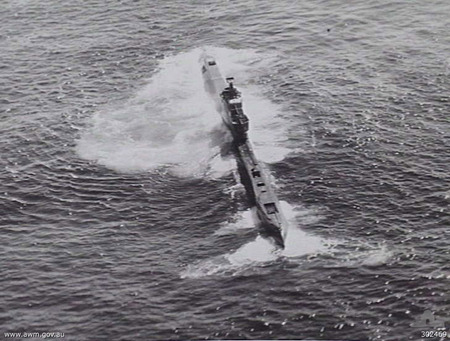
HMS Phoenix surfacing during an exercize
She patrolled the Aegean Sea, Dodecanese in the summer and under Lt Cdr Gilbert Hugh Nowell she teamed with HMS Rorqual, screening a British supply convoy from Malta to Alexandria. She reported on 8 July the Italian battle fleet, later leading to the Battle of Calabria. Drung it, HMS Phoenix fired torpedoes at Giulio Cesare and Conte di Cavour but missed. Later off Augusta, Sicily, she fired at the TB Albatros but missed, but the latter depht charged her in response and she sank with all hands.
 HMS Poseidon
HMS Poseidon
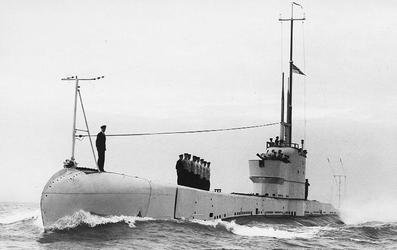
HMS Poseidon was ordered to Vickers Shipbyard, Barrow in Furness, laid down on 5 September 1928, launched 22 August 1929 and commissioned on 5 May 1930. She was posted to the China Station. On 9 June 1931 while surfaced with the tender Marazion 20 mi (32 km) of Weihaiwei, and despite excellent visibility, she collided with the Chinese merchant vessel SS Yuta, far larger than her. The shock ruptured the pressure hull, causing rapid flooding. 31 out of 52 managed to leave her before she sank to the seabed under just 130 ft (40 m) in minutes. Due to this, there was still hope to save the remaining trapped crew.
HMS Hermes came to rescue assisted by the HMS Berwick and HMS Perseus. Since she had sets of Davis Submerged Escape Apparatus, a closed circuit underwater breathing system and canvas drogue there was hope, but se lacked the specialised escape compartments/flooding valves; Still, due to the shallow waters, 8 of the crew managed to leave her forward end, but 2 failed to reach the surface, leaving 21 inside. This escape led the Admiralty to made instruction changes for escape by March 1934.
The wreck was salvaged by China in 1972. Salors were inhumated in the former British naval cemetery on the island of Liugong. This was rediscovered long after, leading to a documentary film “The Poseidon Project“.
 HMS Proteus
HMS Proteus
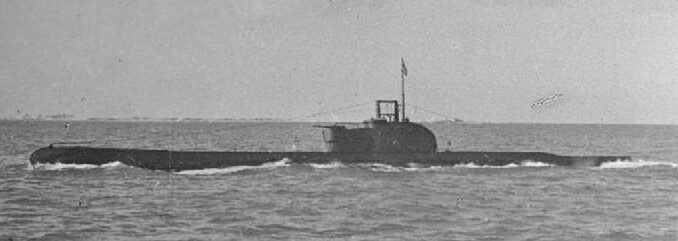
HMS Proteus was ordered to Vickers, Barrow, laid down 19 July 1928, launched 22 August 1929, Completed on 17 June 1930 but Commissioned since 5 May. She was assigned to the China Station, Hong Kong. In July 1939 she was in refit at Singapore NyD. After trials back to Hong Kong in January 1940 and a first war patrol, she was ordered to the Mediterranean on 2 April, Alexandria, 1st Flotilla. On 4 July 1940 after Operation Catapult and Mers-el-Kébir she patrolled for Vichy French targets of opportunity. On 9 August she collied with an Admiralty tug at Malta, repaired, and resuled her patrols, now off Messina, Calabria and Libya. In November she was ordered to Britain, refitted at Portsmouth until July 1941. She trained in Holy Loch and received new radars.
By September 1941 she was reassigned to the Mediterranean, Malta base, to patrol off Greece. She had engine issues and was repaired in Alexandria. She claimed the troopship Ithaka on 10 November, the first radar guided submarine attack, performed in very low vibility.
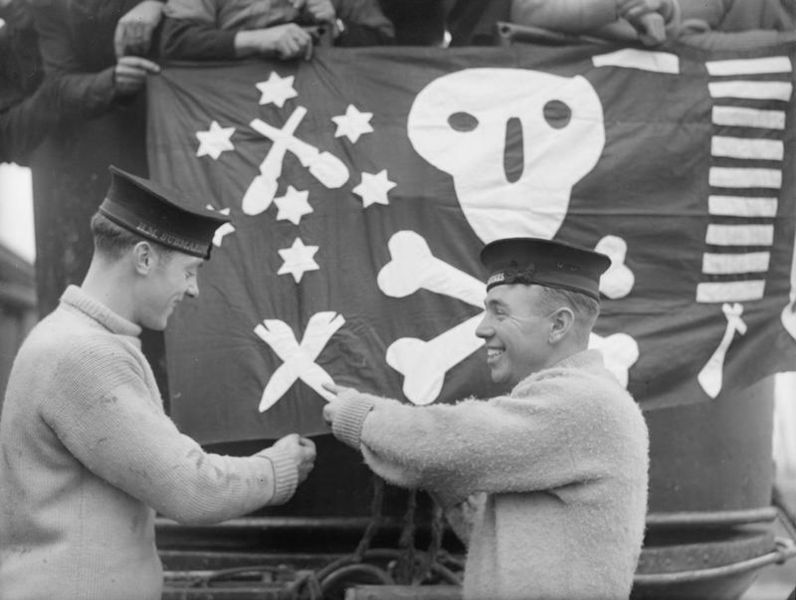
On 8 February 1942 off Lefkada, she sighted an undisticnt dark shape astern, believed it to be an enemy submarine so she fired her stern tubes, then made a 360° to fire her bow tubes, when realizing this was the Italian torpedo boat Sagittario, rapidly approaching to ram her. She narrowly avoided the collision but her extended hydroplane tore Sagittario’s bow plating. She made a crash dive and managed to escape unharmed. In total, HMS Proteus with her 14 war patrols became the most successful of the class. Her engine problems had her back to Britain for repairs by September 1942 in Devonport, until May 1943, but by then it was believed she would be better for training in the River Clyde, until decommission on 30 June 1944. Thus, she became the only one to survive WW2.

 Latest Facebook Entry -
Latest Facebook Entry -  X(Tweeter) Naval Encyclopedia's deck archive
X(Tweeter) Naval Encyclopedia's deck archive Instagram (@navalencyc)
Instagram (@navalencyc)





 French Navy
French Navy Royal Navy
Royal Navy Russian Navy
Russian Navy Armada Espanola
Armada Espanola Austrian Navy
Austrian Navy K.u.K. Kriegsmarine
K.u.K. Kriegsmarine Dansk Marine
Dansk Marine Nautiko Hellenon
Nautiko Hellenon Koninklije Marine 1870
Koninklije Marine 1870 Marinha do Brasil
Marinha do Brasil Osmanlı Donanması
Osmanlı Donanması Marina Do Peru
Marina Do Peru Marinha do Portugal
Marinha do Portugal Regia Marina 1870
Regia Marina 1870 Nihhon Kaigun 1870
Nihhon Kaigun 1870 Preußische Marine 1870
Preußische Marine 1870 Russkiy Flot 1870
Russkiy Flot 1870 Svenska marinen
Svenska marinen Søværnet
Søværnet Union Navy
Union Navy Confederate Navy
Confederate Navy Armada de Argentina
Armada de Argentina Imperial Chinese Navy
Imperial Chinese Navy Marinha do Portugal
Marinha do Portugal Mexico
Mexico Kaiserliche Marine
Kaiserliche Marine 1898 US Navy
1898 US Navy Sovietskiy Flot
Sovietskiy Flot Royal Canadian Navy
Royal Canadian Navy Royal Australian Navy
Royal Australian Navy RNZN Fleet
RNZN Fleet Chinese Navy 1937
Chinese Navy 1937 Kriegsmarine
Kriegsmarine Chilean Navy
Chilean Navy Danish Navy
Danish Navy Finnish Navy
Finnish Navy Hellenic Navy
Hellenic Navy Polish Navy
Polish Navy Romanian Navy
Romanian Navy Turkish Navy
Turkish Navy Royal Yugoslav Navy
Royal Yugoslav Navy Royal Thai Navy
Royal Thai Navy Minor Navies
Minor Navies Albania
Albania Austria
Austria Belgium
Belgium Columbia
Columbia Costa Rica
Costa Rica Cuba
Cuba Czechoslovakia
Czechoslovakia Dominican Republic
Dominican Republic Haiti
Haiti Hungary
Hungary Honduras
Honduras Estonia
Estonia Iceland
Iceland Eire
Eire Equador
Equador Iran
Iran Iraq
Iraq Latvia
Latvia Liberia
Liberia Lithuania
Lithuania Mandchukuo
Mandchukuo Morocco
Morocco Nicaragua
Nicaragua Persia
Persia San Salvador
San Salvador Sarawak
Sarawak Uruguay
Uruguay Venezuela
Venezuela Zanzibar
Zanzibar Warsaw Pact Navies
Warsaw Pact Navies Bulgaria
Bulgaria Hungary
Hungary

 Bundesmarine
Bundesmarine Dutch Navy
Dutch Navy Hellenic Navy
Hellenic Navy Marina Militare
Marina Militare Yugoslav Navy
Yugoslav Navy Chinese Navy
Chinese Navy Indian Navy
Indian Navy Indonesian Navy
Indonesian Navy JMSDF
JMSDF North Korean Navy
North Korean Navy Pakistani Navy
Pakistani Navy Philippines Navy
Philippines Navy ROKN
ROKN Rep. of Singapore Navy
Rep. of Singapore Navy Taiwanese Navy
Taiwanese Navy IDF Navy
IDF Navy Saudi Navy
Saudi Navy Royal New Zealand Navy
Royal New Zealand Navy Egyptian Navy
Egyptian Navy South African Navy
South African Navy






























 Ukrainian Navy
Ukrainian Navy dbodesign
dbodesign